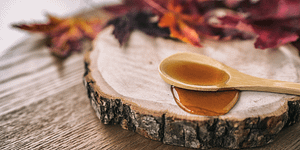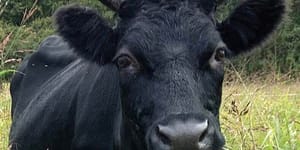Plant Spotlight: The Joyful Juneberry

All hail the joyful juneberry! While these rich and sweet berries taste wonderful when they’re fresh, you can also preserve them, use them as a substitute for blueberries in dessert recipes, and used to make wine, beer or cider. To create these delicious dishes, you first need to find and harvest juneberries. Get ready to set out on a sweet summertime adventure!
The following is an excerpt from Cold-Hardy Fruits and Nuts by Scott Serrano and Allyson Levy. It has been adapted for the web.
The Joyful Juneberry

Although people have been eating juneberries for thousands of years, they are still relatively unknown as a food crop in modern American culture. There are about twenty to twenty-five species of juneberries (Amelanchier) growing in almost every part of North America: in open plains, forests, dry woods, mountain regions, sheltered slopes, wood margins, conifer forests, and pine barrens.
The various species grow across wide areas that overlap, and their range extends from Alaska across the bottom of Canada, south through the Midwest and East Coast, down to Texas and Florida.
The Juneberry: A Brief History
Juneberries were widely used by Indigenous tribes as an important food source and an ingredient in pemmican, a food that is a blend of berries, dried meat, and fat. Pemmican became a way to preserve food that nourished tribes through long winters, and the use of juneberries as a survival food was passed on to the explorers who traveled across the United States. Lewis and Clark, for instance, used the small fruits as a survival food as they traveled west across the Plains.
In our neck of the woods in upstate New York, juneberries are traditionally referred to as shadblow or shadbush, because they produce early-spring flowers that coincide with the seasonal migration of shad fish swimming up the Hudson River. These names are specific to the Amelanchier species (A. laevis and A. canadensis) growing along the East Coast in forest areas. In western North America the name saskatoon (A. alnifolia) is a reference to the bush form of juneberry that grows in sunny prairies and the Canadian provinces above California and Washington.
These plants are the juneberries most commonly cultivated for commercial fruit production, and sold in the nursery trade as fruiting shrubs. But unfortunately, the plants that nurseries sell are often mislabeled, because many Amelanchier species are difficult to distinguish. This only becomes more challenging given the different species have been crossed with one another to produce numerous hybrids.
Growing A Juneberry Tree or Bush
A juneberry tree or bush could be a great addition to any garden or backyard for its delicious fruit and stunning displays of early-spring flowers, which are a welcome sight after a long winter.
 Growth Difficulty Rating: 2
Growth Difficulty Rating: 2
Juneberry is adaptable and fairly easy to grow, although the plants and fruits are susceptible to several pests and diseases.
Taste Profile & Uses for the Juneberry
The fruit looks most similar to a blueberry in appearance, but it is technically not a berry but a pome, which ranges in size from ⅜ to ⅝ inch (1–1.6 cm), depending on the species or cultivar. They start out green and develop a range of colors from fuchsia, to maroon-red, to dark purple and almost black, overlaid with a waxy bloom. The flesh is soft and contains a few edible seeds that taste pleasantly similar to almond.
Although some sources liken the flavor of juneberries to the taste of a blueberry, this is not quite correct. They have a unique flavor that combines several different popular fruits including dark cherries, blueberries, apples, and raisins, with a finish of almonds. Some people may find that juneberry is sweet but bland because the fruit is very low in acidity and lacks the sour notes that give many good fruits a balanced flavor. We think that this is one case where the seeds actually make the fruit to taste better.
The fruits are an excellent source of iron and vitamins A and E, and have high levels of protein, magnesium, calcium, potassium, and antioxidants6.
Juneberries have a short picking season and reach peak flavor over a few weeks, and the best way to enjoy this fruit is fresh off the branch. The fruit can be used as a substitute for any baked item that requires a blueberry. Juneberry pies are amazing.
Plant Description
All of the plants in the Amelanchier genus make handsome garden additions. You’ll find a variety of plant shapes and sizes depending on the species and their cultivars, ranging from bushes that are about 4 feet (1.2 m) high to trees that can be 25 feet (7.6 m) or taller. Juneberry stems produce simple, alternately arranged leaves that are round-oval to oblong-oval, with finely toothed edges. Individual species can grow leaves and flower buds that are tomentose (hairy), or grow leaves that are completely glabrous (smooth). Juneberry trees and shrubs display magnificent fall foliage in a whole range of colors including yellow, orange, and crimson red.
 Flowers
Flowers
Juneberry trees feature attractive star-shaped white flowers with five narrow petals that range in size from ½ to 1¼ inches (1.3–3.2 cm) long. These form on pendulous racemes (flower clusters) that are 2 to 4 inches (5.1–10.2 cm) in length and open in early spring when the leaves have not completely emerged from their leaf buds. Although the flowers are small, a mature juneberry tree in full sun can produce spectacular displays of blossoms that have many of the best decorative attributes of a flowering cherry tree.
Pollination Requirements
Juneberries are self-fertile but will produce more fruit with another tree or bush planted nearby.
Juneberry Site and Soil Conditions
Juneberry plants tolerate a wide range of growing conditions, from coarse sandy soil to poor-quality dirt with heavy clay content, and they are adaptable to many different planting areas as long as the soil is well drained. Because the trees are found growing in shady forest areas, many sources list them as being able to grow in locations with a lot of shade, but in our gardens A. alnifolia and A. canadensis were constantly plagued by disease problems when planted in part shade.
Individual parts of the United States may have less disease exposure, but we feel that for fruit production, juneberry trees should be planted in full sun. The plants in this genus are often mixed up, and there are many misleading assumptions about growing juneberry. In general, the species that are moderate-sized shrubs are mostly native to the western part of the United States and Canada, where they are found growing in full sun. The species endemic to eastern North America tend to grow into multi-trunked, medium-sized trees that can flower in shaded conditions but will ultimately produce larger crops and have fewer pest problems in full sun.
Hardiness
Juneberry hardiness varies with different species and is a reflection of the diverse geographic range of individual species. A. arborea, A. alnifolia, A. laevis, and A. × grandiflora are rated as being hardy to zone 4, or −30°F (−34°C); A. canadensis is rated at zone 3, or −40°F (−40°C).
Fertilization and Growth
Juneberries are adaptable plants that grow in many types of soil conditions, and while they will survive with little effort, a gardener will be rewarded with better fruit crops by enriching the soil with a thick yearly application of compost. Some types of juneberry may be prone to suckering; you can prune these into a neater plant with three to four trunks if you wish.
 Juneberry Cultivars
Juneberry Cultivars
With so many species and hybrids between the species, it is difficult to know which plants to select for a particular site. We feel some of the best juneberry cultivars are from the cultivated variety A. × grandiflora, which is a cross between A. laevis and A. arborea, and there are many cultivars that resulted from this hybridization in the nursery trade. We planted the ‘Autumn Brilliance’ cultivar of A. × grandiflora, which lived up to its name by producing outstanding fall color displays in addition to good crops of flavorful fruit.
‘Autumn Brilliance’: A lovely shade tree that grows to 25
feet (7.6 m), produces good-quality fruit, and is hardy to −35°F (−37°C). The cultivar is fairly pest-free, but we do get small amounts of cedar rust each year.
‘Regent’ (A. alnifolia): A compact, early-flowering cultivar that grows 4 to 6 feet (1.2–1.8 m) tall, with extra-sweet fruit. It is hardy to zone 4 (−30°F/−34°C) and has good disease resistance.
‘Thiessen’ (A. alnifolia): Introduced in Saskatchewan in 1978, this cultivar is a large bush that grows 12 to 15 feet (3.7–4.6 m) high and yields the largest fruit of all the juneberry varieties.
Propagation
Juneberry cultivars that produce suckers near the base can be dug out of the ground with a small section of root attached to the bottom of the suckering branch. This is best accomplished in late winter to early spring, before the plants start flowering. You can also start juneberries from seed that has been subjected to cold stratification; however, up to a third of the seedling plants will end up being different from the parent plant.
Pests and Problems
Rust (Gymnosporangium spp.), leaf spot (Entomosporiumspp.), fire blight (Erwinia amylovora), and powdery mildew are all problems that occasionally affect juneberry plants, particularly in seasons that are excessively rainy. We feel that the high humidity of the Northeast can lead to problems with powdery mildew and fungal diseases; planting the trees in full sun may help to alleviate these problems. Discarding any of the diseased parts of the tree will also help to keep the plant healthy.
But by far, the biggest pests are birds, which will gladly strip the fruit off trees before it’s fully ripe. Still, almost-ripe juneberries that have turned to a deep scarlet-red are good enough to use for making pies, even if they do not have the sweetest flavor. Sometimes it is better to pick a large harvest of underripe berries for baking, instead of waiting a week to get a small harvest of fully ripe fruit left by the birds.
Recommended Reads
The Hunt for Wild Huckleberries and Buckwheat Huckleberry Buckle Cake
Recent Articles
What’s so great about oyster mushrooms? First, you can add them to the list of foods that can be grown indoors! They are tasty, easy to grow, multiply fast, and they love a variety of substrates, making oyster mushrooms the premium choice. The following is an excerpt from Fresh Food from Small Spaces by R. J.…
Read MoreEver heard the phrase, “always follow your nose?” As it turns out, this is a good rule of thumb when it comes to chicken manure. Composting chicken manure in deep litter helps build better chicken health, reduce labor, and retain most of the nutrients for your garden. The following is an excerpt from The Small-Scale Poultry…
Read MoreIn her book, The Art of Science and Grazing, nationally known grazing consultant Sarah Flack identifies the key principles and practices necessary for farmers to design, and manage, successful grazing systems. This book is an essential guide for ruminant farmers who want to crate grazing systems that meet the needs of their livestock, pasture plants,…
Read MoreWant to start your own medicinal herb garden? Passionflower, lemon balm, and goldenseal are great places to begin! These herbs are jam-packed with medicinal properties and easy to grow in a majority of climates.
Read More











